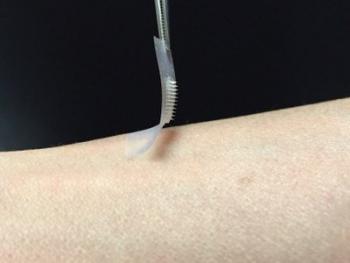Patients with diabetes have to control their blood sugar by regularly pricking their finger and giving themselves insulin
shots. The procedure is painful and imprecise – injecting the wrong amount of insulin can lead to serious complications, and in some
cases, coma and death.

The researchers aim to develop a smart insulin patch that would only need to be changed every few days.
Image credit: Zhen Gu
Now, the development of a “smart insulin patch” could one day make such an ordeal a thing of the past for the millions of
Americans who suffer from diabetes, according to the team behind the innovation, which includes members from the University of North
Carolina (UNC) in Chapel Hill and NC State in Raleigh.
The smart patch – a square sliver of tape no larger than a penny – has more than a hundred microneedles, each about the size of an
eyelash, containing tiny reservoirs of insulin and glucose-sensing enzymes.
The device – which can be placed anywhere on the body – senses when blood sugar levels get too high and rapidly discharges
the right amount of insulin into the bloodstream.
In the Proceedings of the National Academy of Sciences, the diabetes doctors and biomedical engineers that invented the
painless patch describe how they tested it in a mouse model of type 1 diabetes and showed it lowered blood glucose for several
hours.
While it shows great promise, it is too early to say if and when the patch can be used in human patients – the team says more
tests and then clinical trials are needed.
Patch mimics body’s own system for generating insulin
The smart insulin patch works by mimicking the body’s own system for generating insulin – the beta cells of the pancreas – which
produce and store insulin in tiny sacs or vesicles. They also sense changes in blood sugar and signal insulin to be released from the
vesicles as needed.
The team constructed artificial vesicles that perform in a similar way out of two natural materials – hyaluronic acid (HA) used in
cosmetics and 2-nitroimidazole (NI), an organic compound used in diagnostics.
Together, the two compounds form a molecule that is water-loving at one end (the HA part) and water-repellent at the other
(the NI part). Groups of the molecule self-assemble into vesicles – rather like oil droplets do in water – with the water repellent
ends on the inside and the water-loving ends on the outside.
The researchers found they could insert a core of solid insulin and enzymes designed to detect glucose into the artificial
vesicles, which in large numbers formed millions of bubble-like nanostructures, each 100 times smaller than the thickness of human
hair.
When they tested the intelligent insulin nanoparticles in the lab, the team found they responded to raised blood sugar. The excess
glucose molecules entered the artificial vesicles, using up oxygen as the enzymes on board converted them into gluconic acid. This
reduction in oxygen or “hypoxia” makes the water-repellent NI end of the molecules that make up the vesicles become water-loving, and
the vesicles dissolve and release insulin into the bloodstream.
Patch kept blood sugar normal in diabetic mice for hours
The next step for the researchers was to find a way to administer the artificial vesicles to diabetes patients. This is when they
turned to the idea of tiny microneedles incorporated into a patch, rather than rely on the large needles or catheters of the “closed-loop
systems” of other approaches to glucose-sensitive insulin delivery.
They eventually produced a silicon strip with over a hundred microneedles that pierce the skin and tap into the blood flowing in
the underlying capillaries. Each microneedle contains a reservoir of the artificial vesicles.
The team tested the invention in a mouse model of type 1 diabetes. They gave one group of mice a standard insulin injection – the
levels dropped to normal but then quickly rose to hyperglycemic levels.
But when they treated another group of diabetic mice with the patch, their blood sugar levels normalized within half an
hour and stayed that way for several hours.
The researchers also found that by varying the dose of enzyme, they could fine-tune the patch to alter glucose levels within
certain ranges.
A ‘game changer’ for diabetes patients
Mice are less sensitive to insulin than humans, so the researchers believe that the patches could last even longer in human
patients. The researchers aim to develop a smart insulin patch that would only need to be changed every few days.
Such a prospect would be a “game changer” for diabetes patients, explains co-senior author John Buse, a professor of medicine and
past president of the American Diabetes Association:
“The hard part of diabetes care is not the insulin shots, or the blood sugar checks, or the diet but the fact that you
have to do them all several times a day every day for the rest of your life.”
Co-senior author Zhen Gu, a professor in biomedical engineering, says:
“We have designed a patch for diabetes that works fast, is easy to use, and is made from nontoxic, biocompatible
materials. The whole system can be personalized to account for a diabetic’s weight and sensitivity to insulin, so we could make the
smart patch even smarter.”
There are more than 387 million people with diabetes worldwide, and the number is predicted to rise to 592 million by 2035.
Funds from the NC TraCS Institute and the American Diabetes Association helped finance the research.
Meanwhile, MNT recently learned how a new screening tool identified a drug that could
target an underlying cellular cause of type 2 diabetes that leads to insulin resistance.
Written by Catharine Paddock PhD